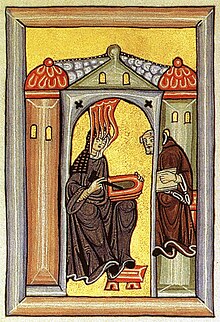Years ago I performed a ritual invocation at Samhain with this haunting, visionary rendition of Hildegard Von Bingham's "O Successores Fortissimi Leonis" by the group Vox, recorded in the early 1990's. The invocation was done at my "Rites of Passage" Gallery in Berkeley, California, in honor of the approach of Samhain, the last harvest festival, the time to homor the Beloved Dead, and also the time when "the veils between the Worlds are thin". The Invocatioin was done with 4 women in a circle, turning the circle with gestures of offering. It was one of the most beautiful performances I've done, well remembered.
I recently played the piece again and was delighted to find it had been uploaded on UTube. Von Bingham's vision and prayers reach across the ages to touch me again, on the unimaginable Internet. I just felt like sharing it again, here.
 |
| From "The Dinner Party" by Judy Chicago |
 |
Illumination from the Liber Scivias
showing Hildegard receiving a vision
and dictating to her scribe and secretary
|
She wrote on topics ranging from philosophy to natural healing with a critical expertise praised by both German advice-seekers and the highest-ranking figure in the Church, Pope Eugenius III. An esteemed advocate for scientific research, Hildegarde was one of the earliest promoters of the use of herbal medicine to treat ailments. She wrote several books on medicine, including Physica, circa 1150, which was primarily concerned with the use of herbs in medicinal treatment.
Hildegarde may be best known as a composer.
Stemming from the traditional incantations of Church music, Hildegarde’s compositions took the form of a single chant-like, melodic line. These compositions are called antiphons and are a single line of music sung before and after a psalm. Hildegarde combined all of her music into a cycle called Symphonia Armonie Celestium Revelationum, circa 1151, orThe Symphony of the Harmony of the Heavenly Revelations, which reflects her belief that music was the highest praise to God.
Stemming from the traditional incantations of Church music, Hildegarde’s compositions took the form of a single chant-like, melodic line. These compositions are called antiphons and are a single line of music sung before and after a psalm. Hildegarde combined all of her music into a cycle called Symphonia Armonie Celestium Revelationum, circa 1151, orThe Symphony of the Harmony of the Heavenly Revelations, which reflects her belief that music was the highest praise to God.
** "The Dinner Party" by Judy Chicago, Brooklyn Museum of Art https://www.brooklynmuseum.org/eascfa/dinner_party/place_settings/hildegarde_of_bingen

1 comment:
Fascinating! I learn so much from your posts, Lauren!
Post a Comment